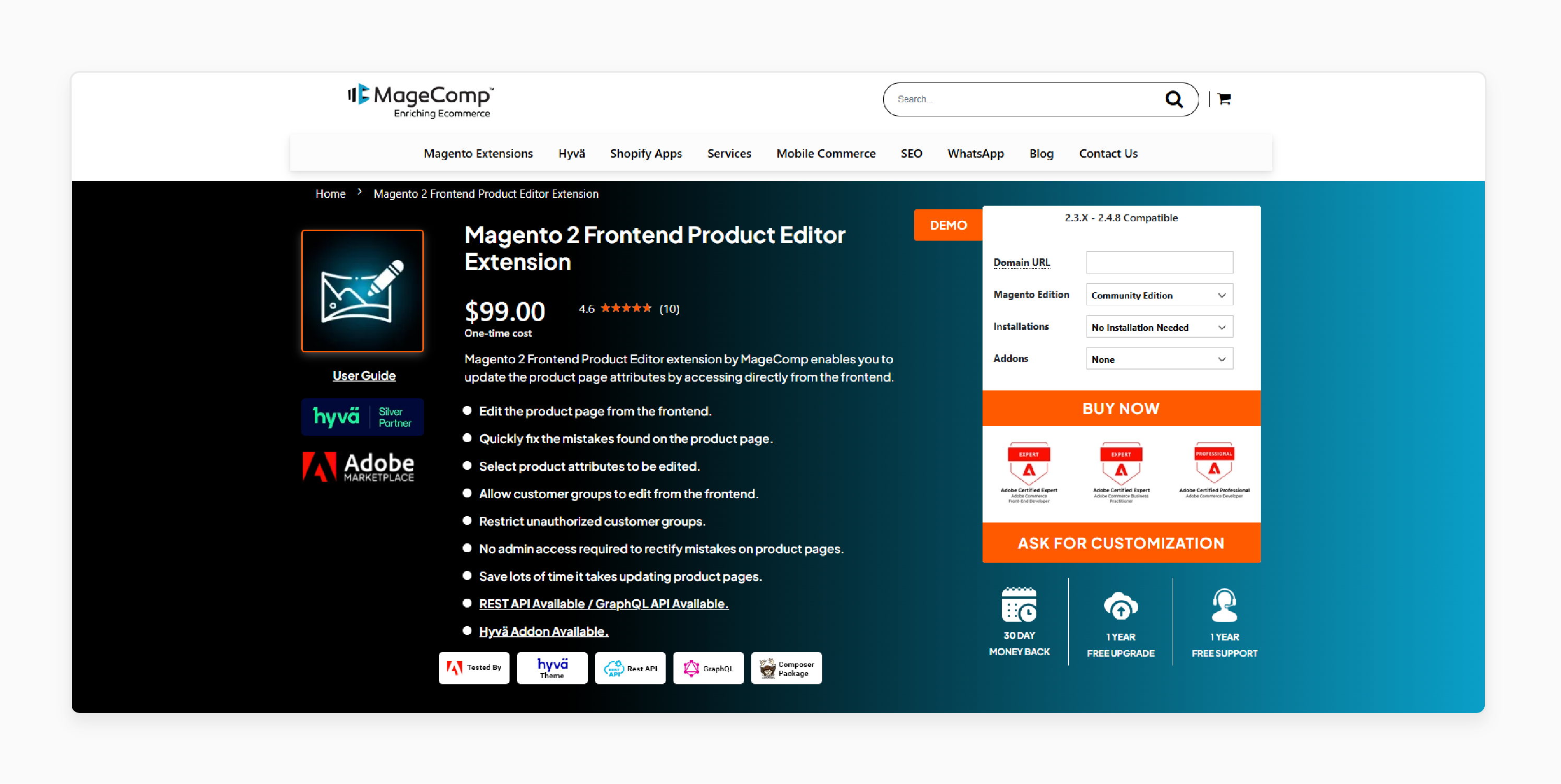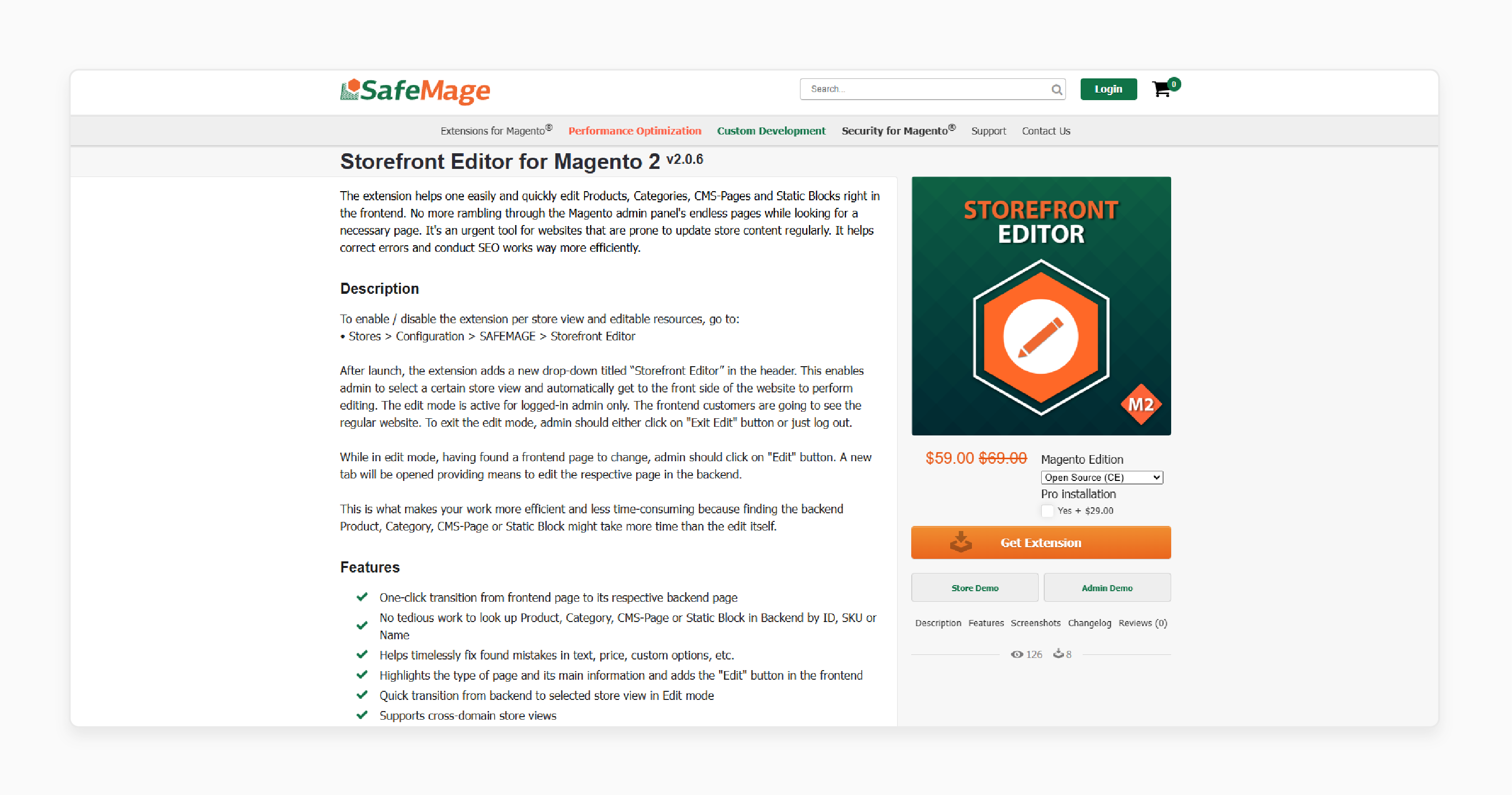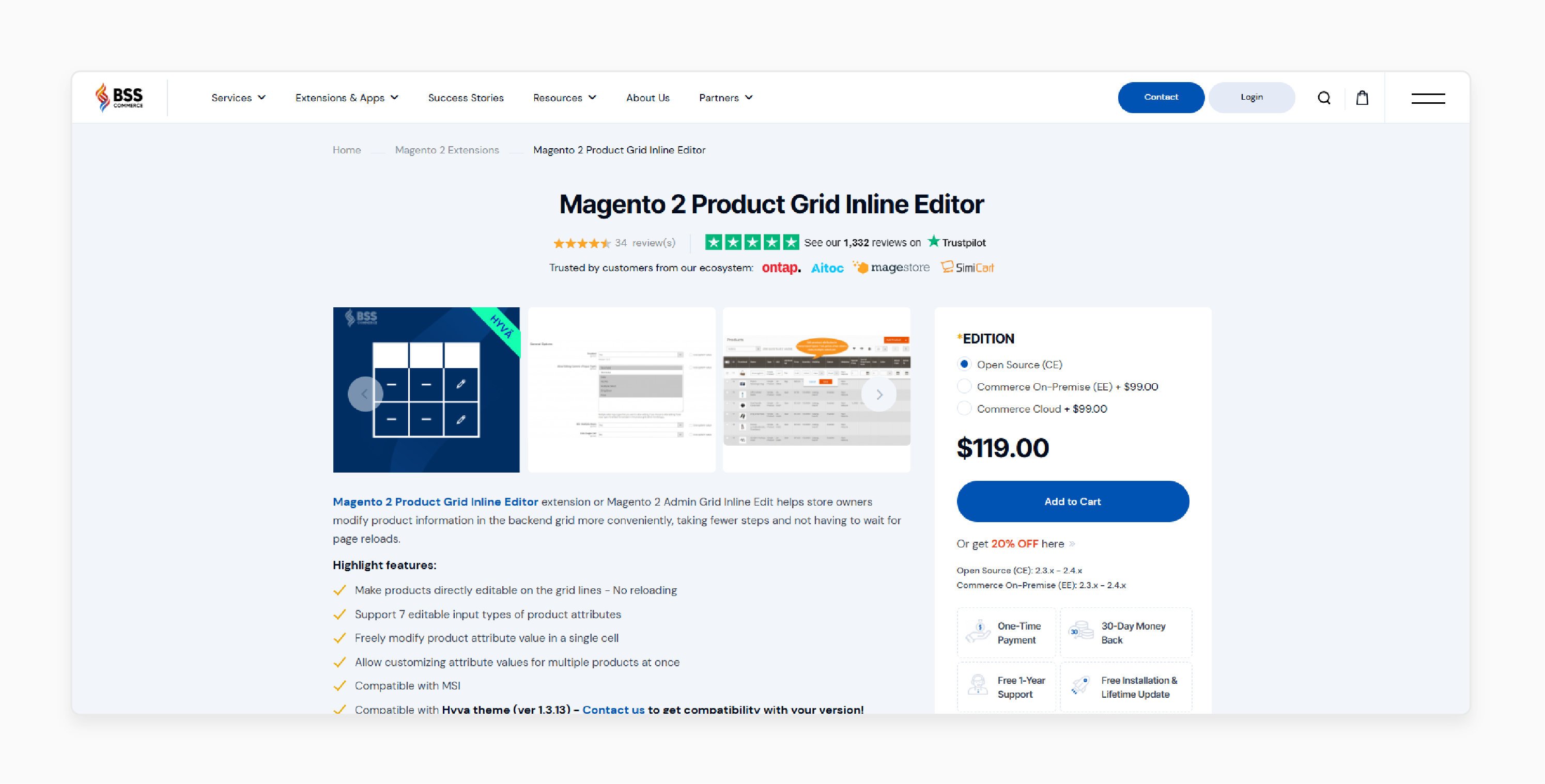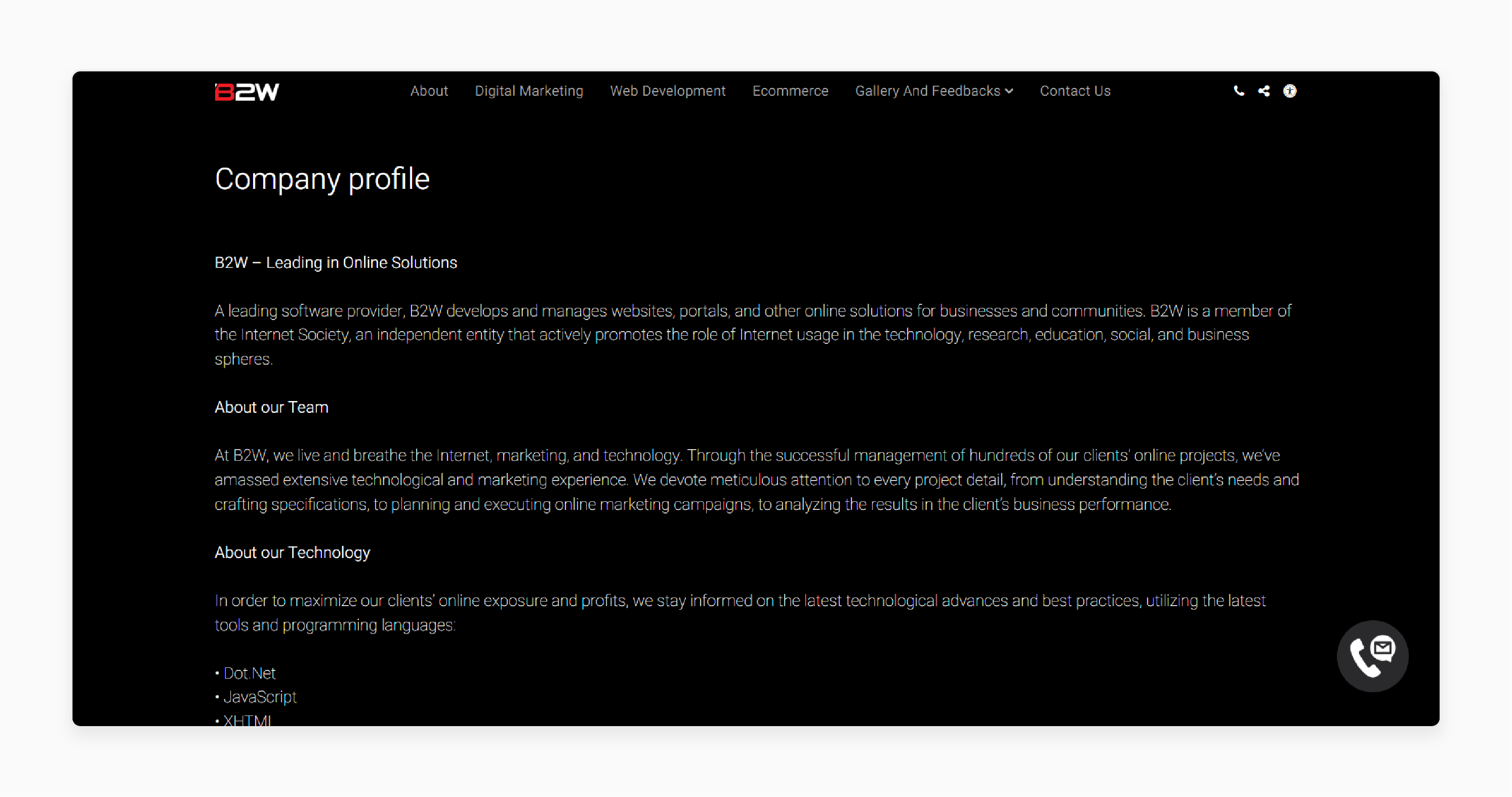
Top 3 Magento 2 Frontend Product Editor Extensions
Is your team losing valuable time switching between the back and front end to update prices? Magento 2 frontend product editor extensions let you make edits from your storefront.
The article explores the key features, best practices, and top frontend product editor extensions.
Key Takeaways
-
Magento 2 frontend product editor simplifies product updates without backend access.
-
The main features of the extension include inline editing and WYSIWYG descriptions.
-
Popular Magento 2 frontend product editor extensions offer unique benefits.
-
Pre-installation requirements help avoid compatibility and permission issues.
-
Brands use frontend editors to improve workflow and product management.
-
8 Pre-Installation Requirements for Frontend Product Editor Extensions
-
5 Common Challenges and Solutions of Frontend Product Editor
What is Magento 2 Frontend Product Editor?
“Frontend product editor allows store owners to edit product information from the storefront. There are no need to access the admin panel.”
The tool enables live, inline editing of product titles and images. Use a user-focused interface on the frontend.
The functionality is helpful for non-technical staff as they need to make quick updates. Many frontend editors include WYSIWYG editors and AJAX updates to control user access.
These editors improve workflow efficiency and reduce reliance on backend navigation. It is ideal for B2B stores or multi-vendor platforms. It helps simplify product management and enhance operational flexibility. It also maintains role-based security controls.
8 Key Features of Magento 2 Frontend Product Editor
1. Inline Product Editing on Frontend Pages
-
Users can edit product information right on the storefront.
-
You can change fields like product name and quantity by clicking on the product details. Then, enter the new data.
-
The feature helps save time and reduce admin panel dependency for routine edits.
2. WYSIWYG Editor for Descriptions
-
The frontend editor integrates with Magento’s built-in WYSIWYG editor.
-
It allows users to manage rich text fields such as long descriptions or custom HTML content.
-
You can update a product description to include seasonal promotional details. You can also include bold text and images.
-
It eliminates the need to understand HTML or code. Visual editing also helps non-technical staff.
3. AJAX-Powered Real-Time Updates
-
AJAX, Asynchronous JavaScript, and XML technology allow users to save changes.
-
While editing prices on various products, changes get saved one by one. It doesn’t interrupt the flow.
-
It eliminates the need to reload the page. It helps create a smooth, modern editing experience. It provides faster, more efficient updates and a better user experience.
4. Frontend Image & Media Management
-
Users can add or replace product images from the frontend. They can use a drag-and-drop interface or image upload dialogs.
-
It reduces the steps and allows image updates without backend media training.
5. Role-Based Access and Permissions
-
Admins can configure who can access the frontend product editor. It depends on user roles or groups.
-
For example, only vendors or product managers can edit their listings.
-
It ensures security and proper control over product data.
6. Custom Attribute Editing
-
Along with standard attributes, you can display and edit custom attributes. You can edit them via the frontend interface.
-
These attributes include fabric type and warranty period.
-
It provides complete attribute control without backend complexity.
7. Quick Save and Bulk Edit Capabilities
-
Advanced editors may offer extra tools. These include quick-save buttons and bulk editing of various products at once.
-
You can apply a 10% discount across 20 products using the bulk edit tool on the frontend.
-
It helps save time for promotional changes or catalog-wide updates. Store owners save 60–70% of their time compared to traditional editing.
8. Improved Workflow and Collaboration
-
Frontend editing enables faster collaboration between sales and vendor teams. It is by reducing reliance on the admin panel.
-
It helps simplify workflows and enables better team coordination. It also eliminates the need for training for backend usage.
Top 3 Magento 2 Frontend Product Editor Extensions
1. Magento 2 Frontend Product Editor Extension - Magecomp

Magecomp’s frontend product editor extension helps you update the product page attributes. You can access it from the frontend. It is compatible with Magento 2.3.x - 2.4.8.
Key Features:
-
Fix the mistakes found on the product page.
-
Edit select product attributes.
-
Allow customer groups to edit from the frontend.
-
Restrict unauthorized customer groups.
-
It doesn't need admin access to rectify mistakes on product pages.
-
Save lots of time it takes to update product pages.
-
REST API Available / GraphQL API Available.
-
Hyvä Addon Available.
Price: $99 (12 months)
2. Storefront Editor for Magento 2 - Safemage

Safemage’s storefront editor extension helps edit products and blocks on the frontend. You don’t need to ramble through the admin panel's endless pages while looking for a necessary page. It is an urgent tool for websites prone to updating store content. It helps correct errors and conduct SEO work better.
Key Features:
-
The one-click transition from the front-end page to its respective backend page.
-
No tedious work to look up a product or static block in the backend by ID or name.
-
Helps fix found mistakes in text and custom options.
-
Highlights the type of page and its main information.
-
Adds the "Edit" button in the frontend.
-
Quick transition from backend to selected store view in Edit mode.
-
Supports cross-domain store views.
-
Security measures for frontend and admin sessions.
Price:
-
Magento Open Source Edition: $59 (12 months)
-
Magento Commerce Edition: $111 (12 months)
3. Magento 2 Product Grid Inline Editor - BSS Commerce

BSS Commerce’s product grid inline editor helps store owners change product information. It is in the backend grid. It reduces the steps taken and the time to wait for page reloads. It is compatible with Magento 2.3.x - 2.4.x.
Key Features:
-
Make products editable on the grid lines.
-
Support 7 editable input types of product attributes.
-
Change product attribute value in a single cell.
-
Allow customizing attribute values for various products at once.
-
Compatible with MSI.
-
Compatible with the Hyva theme.
Price:
-
Magento Open Source Edition: $119 (12 months)
-
Magento Commerce Edition: $218 (12 months)
8 Pre-Installation Requirements for Frontend Product Editor Extensions
1. Magento Version Compatibility
-
Before installing any extension. You should test the version and confirm it supports your current Magento 2 version.
-
Extensions built for older or newer versions may cause errors or conflicts. Check it using the Magento admin panel or CLI.
2. PHP Version Compatibility
-
Each version of Magento and its extensions supports specific PHP versions.
-
A mismatch can lead to syntax errors or fatal exceptions. It can lead to unresponsive functionality.
-
Choose PHP 8.1 or 8.2, depending on Magento's compatibility matrix.
3. Composer Availability
-
Most Magento 2 extension installations need Composer. It is especially for premium or marketplace-listed ones.
-
Without Composer, you may be unable to install or update the extension.
-
Ensure to configure the composer.json. Also, ensure you are operating in the Magento root directory.
4. Administrator Access & Correct File Permissions
-
Ensure you have full admin access. Ensure that your file system permissions allow for installation.
-
Incorrect permissions will prevent file writing or compilation. Also, make sure the correct web server user owns the file.
5. Clear Cache and Recompile
-
Disable the Magento cache to avoid loading old data. Run dependency injection (DI) compilation for the extension to function.
-
You can re-enable it after a successful installation and verification.
6. Database and File Backup
Always perform a complete backup before installing any new extension.
-
You can restore your Magento environment in case of a crash or conflict.
-
Back up the full database and Magento file system, including /app and /media.
7. License Key or Vendor Account
-
Some paid extensions need a license key or API token for activation or updates.
-
Installation will fail or lock the features without activation.
-
Register your domain or staging URL in the vendor’s license management portal. It is before starting.
8. Theme Compatibility and Testing
Frontend extensions interact with your live storefront. Ensure they are compatible with your current theme.
Steps to test:
-
Install on a staging environment first.
-
Check for layout or styling issues on product pages. It is especially where the editor appears.
-
If your theme customizes product layouts. Expect to make adjustments in .phtml or CSS files.
Inform your development team in advance so they can test and resolve conflicts.
5 Common Challenges and Solutions of Frontend Product Editor
1. Theme Compatibility Issues
Frontend product editors may not render with custom or third-party themes. UI misalignment or missing fields are common.
Solution:
-
Test the extension on a staging environment before deployment.
-
Use browser developer tools to inspect missing elements or JavaScript errors.
-
Customize template overrides to match your theme structure.
-
Contact the extension vendor for patches if using a customized theme.
2. Permission & Role Misconfigurations
Users may not see editing options due to incorrect ACL settings or role permissions.
Solution:
-
Ensure user roles have the correct permissions in User Roles.
-
Double-check extension-specific permission settings if they exist. Some extensions have custom ACL entries.
-
Clear the cache and re-login as the user to apply updated roles.
3. JavaScript Conflicts
Conflicts between the frontend editor’s JavaScript and existing scripts can break functionality.
Solution:
-
Use the browser console to inspect JS errors.
-
Disable conflicting modules/plugins one by one to isolate the issue.
-
Refactor or defer loading scripts to avoid overlapping functions or namespace conflicts.
4. Slow Performance or Delays
Live editing tools may slow down frontend performance. It is especially on pages with many configurable options or media files.
Solution:
-
Use lazy loading for images and heavy JS components.
-
Optimize product data to reduce JSON payload size.
-
Enable Magento’s full page caching and deploy production mode.
-
Use a CDN to serve assets and speed up UI rendering.
5. Custom Attributes Not Displaying
Custom product attributes may not appear in the frontend editor by default.
Solution:
-
Add attributes to the correct attribute sets.
-
Ensure to mark them as "Visible on Frontend" or "Used in Product Listing".
-
Change editor configuration files or templates. Include those attributes in the editable UI.
3 Real-World Use Cases of Magento 2 Frontend Product Editor
1. Coca-Cola Store

-
Coca-Cola’s official store offers thousands of SKUs, including merchandise and seasonal items.
-
They need frequent updates on product availability and promotions during holidays and events.
-
Using frontend editing tools helps their merchandising team update listings on live pages. It speeds up their time-to-market.
2. B2W Digital

-
B2W Digital allows various vendors to manage products. Vendors update product details with controlled access.
-
It is often through frontend portals or restricted editing tools. These help maintain platform security.
-
It minimizes admin bottlenecks and improves vendor autonomy.
3. Landmark Group
-
Landmark Group uses a frontend product editor. It enables vendors to log in and update their product details on the site without backend access.
-
It ensures quicker listing adjustments across various vendors during sales events. It keeps catalog information fresh and accurate.
FAQs
1. Can regular customers edit products from the frontend?
Reputable extensions restrict editing permissions to specific customer groups or administrative users. Regular customers cannot change product information unless granted permission.
2. How secure are frontend product editing extensions?
Modern extensions include powerful security features. These include customer group restrictions and audit trails. Proper configuration ensures security while enabling productivity benefits.
3. What is the typical cost difference between extensions?
Prices range from $79 per year for basic solutions to $349 for enterprise features. Depending on the required functionality, most stores find value in the $99-199 range.
4. Can I edit various products from the frontend?
Some extensions, like Amasty, offer bulk editing capabilities. Others focus on individual product editing. Choose based on your typical workflow requirements.
5. Do frontend editors work with headless Magento setups?
Extensions with GraphQL and REST API support work well with headless implementations. MageComp and Amasty offer the most comprehensive API integration.
6. How often should I update my product editor extension?
Follow the same update schedule as other Magento extensions. It is every 3-6 months or when the system releases security updates.
7. What happens if the extension conflicts with my theme?
Minor customizations can resolve most of the conflicts that involve CSS styling issues. Choose extensions with good support and theme compatibility documentation.
Summary
Magento 2 frontend product editor enables admins to edit information on the storefront. The article explores the key features of the module, including:
-
Allows inline editing of details and images on the frontend with AJAX-powered saves.
-
Supports role-based access control to restrict editing permissions and maintain data security.
-
Offers bulk edit capabilities and WYSIWYG editors for fast product content management.
-
Popular extensions provide tailored frontend editing features compatible with various Magento versions.
Boost your store’s efficiency using the frontend product editor. Pair it with managed Magento hosting for optimal performance and hassle-free management.


